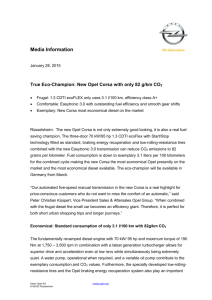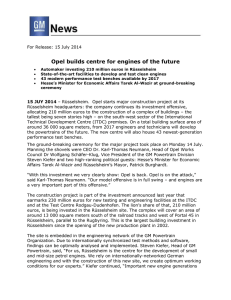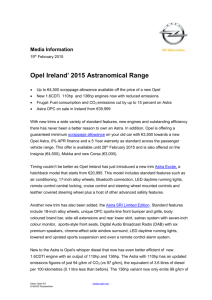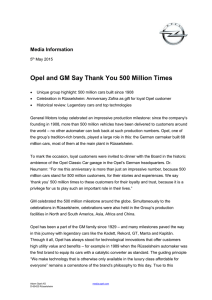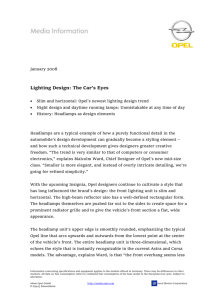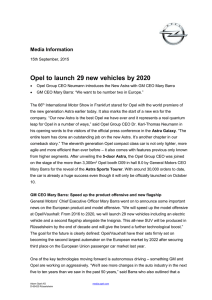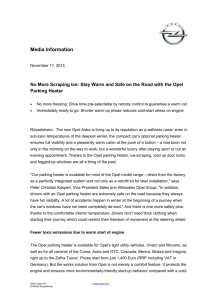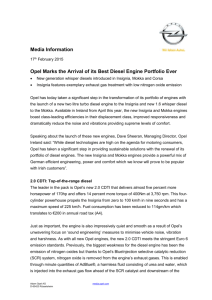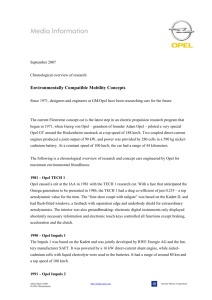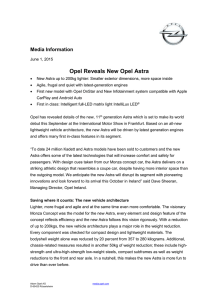Opel Media Information - GM Media
advertisement
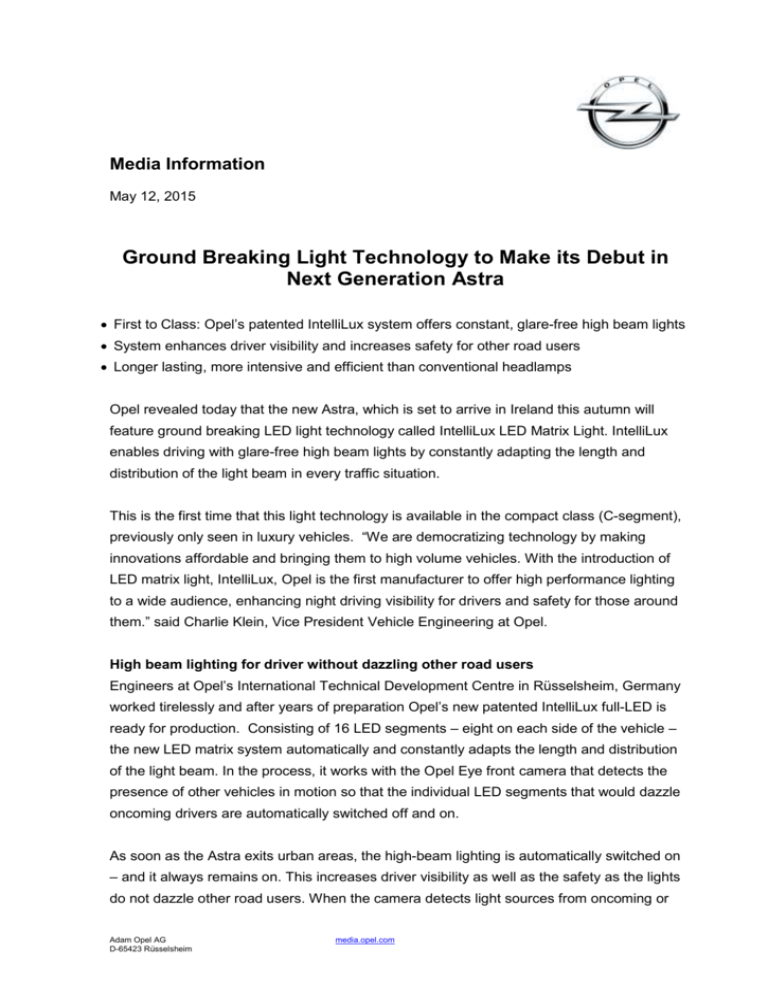
Media Information May 12, 2015 Ground Breaking Light Technology to Make its Debut in Next Generation Astra First to Class: Opel’s patented IntelliLux system offers constant, glare-free high beam lights System enhances driver visibility and increases safety for other road users Longer lasting, more intensive and efficient than conventional headlamps Opel revealed today that the new Astra, which is set to arrive in Ireland this autumn will feature ground breaking LED light technology called IntelliLux LED Matrix Light. IntelliLux enables driving with glare-free high beam lights by constantly adapting the length and distribution of the light beam in every traffic situation. This is the first time that this light technology is available in the compact class (C-segment), previously only seen in luxury vehicles. “We are democratizing technology by making innovations affordable and bringing them to high volume vehicles. With the introduction of LED matrix light, IntelliLux, Opel is the first manufacturer to offer high performance lighting to a wide audience, enhancing night driving visibility for drivers and safety for those around them.” said Charlie Klein, Vice President Vehicle Engineering at Opel. High beam lighting for driver without dazzling other road users Engineers at Opel’s International Technical Development Centre in Rüsselsheim, Germany worked tirelessly and after years of preparation Opel’s new patented IntelliLux full-LED is ready for production. Consisting of 16 LED segments – eight on each side of the vehicle – the new LED matrix system automatically and constantly adapts the length and distribution of the light beam. In the process, it works with the Opel Eye front camera that detects the presence of other vehicles in motion so that the individual LED segments that would dazzle oncoming drivers are automatically switched off and on. As soon as the Astra exits urban areas, the high-beam lighting is automatically switched on – and it always remains on. This increases driver visibility as well as the safety as the lights do not dazzle other road users. When the camera detects light sources from oncoming or Adam Opel AG D-65423 Rüsselsheim media.opel.com Page 2 preceding traffic, individual LEDs in the relevant zone are deactivated, simply “cutting out” the area around the vehicles. The rest of the road and its surroundings remain brightly illuminated. With this degree of precision and adaptation, LED matrix light elevates lighting technology to the next level. This is confirmed in a study conducted by the Technical University of Darmstadt and the European LightSightSafety Initiative. The study found that at driving speeds of 80km/h, drivers detect objects at the side of the road around 30 to 40 meters sooner than with conventional halogen or xenon low beam lighting. This gives them around 1.5 seconds more time to react, for instance when animals suddenly cross the road. As not all Astra customers will opt for a navigation system, the lighting system needs to recognize if the vehicle is in an urban area or on a highway for instance independently. The IntelliLux system is the first matrix light system on a series production car that is continuously optimised without being linked to the navigation system. IntelliLux LED also provides a special motorway light mode that further increases safety at night. And a special welcome light function makes entering and exiting the Astra more comfortable in the dark. Brighter, longer-lasting, more efficient: Opel’s IntelliLux LED scores threefold The LED matrix light’s high efficiency brings added safety and comfort. Not only does the system illuminate the surroundings brighter than conventional lighting systems, it also has a considerably longer running life than headlamps with halogen or xenon lamps. Another advantage is that mechanical movements are no longer necessary in the headlamp – the individual LED segments turn on or off according to the situation, which also contributes to a durability that far exceeds the lifespan of a car. Last but not least, the new lighting system has also made the designers very happy. Before, the size of the headlamps’ housing mainly depended on the most expensive technology it protected, but now the base lamp determines the visible part of the headlamp. Thanks to the small LEDs used in the matrix light, in future, the lamps can be designed more finely and delicately; mechanical, complicated control units that require a lot of space and optically oversized housings are thus outdated. -ENDS- Page 3 Notes to Editors: Opel is a German vehicle manufacturer, headquartered in Rüsselsheim, Germany and is a subsidiary of General Motors (GM). The company was founded in 1862 and began manufacturing vehicles in 1899. Today Opel operates in over 50 countries, has 12 manufacturing facilities in Europe and employs over 34,500 people. In 2014, Opel sold 1.25 million vehicles and has a market share of 5.74% in Europe. From 2014 – 2018, Opel plans to overhaul its model powertrain range with the introduction of 27 new models and 17 new engines. Media Information Laura Condron | Senior Brand & PR Manager | 01 216 1055 | laura.condron@opel.com Text and photos can be downloaded at http://media.opel.ie

